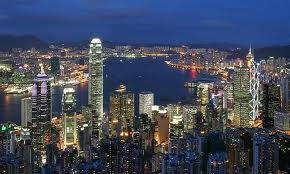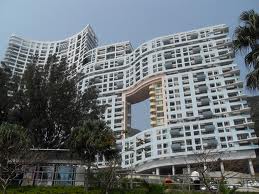The other night I watched a very interesting episode of Adventures With a Purpose on PBS. This show, entitled “Hong Kong: Quest for the Dragon” was hosted by Richard Bangs. During the episode the term/concept of Feng Shui was described and demonstrated in some detail. Here is the best summary of Feng Shui that I have found thus far on the internet:
“Feng Shui and Geomancy is a science of buildings, land, and burial sites and it has more than 2000 years history original from China. The first official record in China history is in “Yi Jing” (or I Ching) which is Ancient Chinese decision-making tool. It’s one of two most famous Chinese oracle, has been consulted in one form or another since the Bronze Age, and people of every era have benefited from its timeless wisdom. It gives people ideas how to evaluate the living and professional environment, making decision on life and optimize life on relationship, career, business and an overall harmony.”
Surprisingly, I had never heard of Feng Shui prior to this program, but found it to be fascinating from both a professional and personal perspective. No one can deny that the principles of Feng Shui have been employed very successfully in Hong Kong, as it is arguably the most vibrant, dynamic, and successful city on the planet.
A quick listing and brief summary of the 15 core principles of Feng Shui prepared by Henry Fong shows many similarities to good urban planning (more details and explanation can be found through the source via the weblink):
- “An integrated and holistic system – our environment is considered to be an integral system as a whole, with Man at the center, including all things “under Heaven and on Earth”. Each of the individual components does not stand-alone; they are mutually connected, mutually restrained, mutually dependent, mutually opposing and mutually transforming.”
- “Being suitable and appropriate to the restriction and limitation of the site – every site has its limitation and advantages. Some places are only suitable for residential use while others are more suitable for commerce or manufacturing, so there is a need to determine what a site is best suitable for, to allow the resultant development to be ‘Ziran’ and not forced or out of balance with its neighbor.”
- “Bound by mountains and near water -physically, mountains are the “skeletons” of the land, they not only provide us with protection from the weather and from our predators [13]; they also provide us with food and resources. Water is the source of life and means of transportation, without water we cannot survive.”
- “Carry the Yin and embrace the Yang – a Feng Shui house should be protected from the cold wind and facing the warm sun.”
- “Observe the form and examine the configuration observation and investigation of the landform to locate the correct site for a dwelling is one of the core principles of Feng Shui” by using six external matters and six internal matters.
- “Examine the geology of the land – Feng Shui practitioners rely on observation of what is above to make an assessment of what is below.”
- “Determine the amount and the standard – Feng Shui thinking has an affinity with sustainable development; the idea is that the population density of a place should be in proportion to the capacity it can sustain.”
- “Take advantage of the Sheng Qi – Sheng Qi is the life force that makes things grows and Sha Qi is the negative opposite that halts the growth of life. Sheng Qi can be cultivated by adjusting the Yin and Yang balance of a situation, so they are in harmony and mutually supports each other.”
- “Suitably located in the middle and residing in the middle; Stand out as the main body in a planning arrangement with the auxiliary buildings surrounding the host; and Neither slanting nor lean against, the building is appropriately located at an advantageous position – The reason why the historical capitals in China were never located in the coastal cities like Guangzhou and Shanghai, or towards the borders like Harbin and Kuming, is because a capital needs to be centrally located. The same idea dictates that an urban business center is always located in the middle of a modern city and the best shops are always located in the middle of a shopping mall.”
- “Aesthetic appreciations – Beauty of the form can include the beauty of the natural landscape, the beauty of natural form and materials, the beauty of man-made objects and the beauty of applied colors and lighting. These are the externally beautiful (Wai Mei 外美)and we appreciate them with our five senses, with the eyesight being the most acute.”
- “Greening the environment – The amount of trees and wood can give an indication of the quality of the Feng Shui of a site.”
- “Feng Shui can be transformed and improved – In the process of enhancement, the natural environment should be respected at all times because if we take out more than what the situation requires and destroy nature in the process then whatever improvement we carry out will not benefit us in the long run.”
- “Yin Yang dialectics to achieve harmony – observe and analyze a situation we can contrast and find the extremes, and by using the Yin Yang dialectics, we can find an appropriate solution lying somewhere within the bound of the two poles.”
- “Being timely and affectionate – the unchanging principle underlying the Form School Feng Shui is human feelings and affections, which enabled us to connect our body and soul to the environment we live and work in.”
Above’s a photograph of an apartment building in Hong Kong that included a hole in the structure in order to improve the site’s positive Feng Shui aspects. The structure was referenced in the television program as well as demonstrates an instance where building design could resolve potential negative aspects. Well-known buildings that have involved Feng Shui design can be seen via this weblink.
So, how does one go about applying Feng Shui to urban planning? Here are a few suggestions:
- Never forget to think outside the box (or your own silo) and to always think holistically when planning.
- The unseen (or the unknown) could be as important as the visual or known – granted this may be hard to quantify or regulate, but do not just arbitrarily discard the notion. Ask lots of questions.
- Remember that for every yin there is a corresponding yang.
- Planners may need to accept that idea that successful placemaking may encompass more than just enhancing the senses of sight, sound, touch, smell, and taste.
- Respecting others, the earth, and the environment are critical in all aspects of daily life, including urban planning.
- How we live our own lives is just as important as how we plan and regulate how the land is used.
- Always…always, be open to new ideas and concepts whether you understand them at first or not. The moment we planners think we know it all is the moment when we should retire.



This is great. Thanks for sharing this.
LikeLike
You are welcome, LeRoy.
LikeLike
It’s like urban design on LSD (in a good way). I get similarly excited about how principles of permaculture can apply to non-urbanized areas. Great post!
LikeLike
Thank you very much.
LikeLike
i appreciate your thinking, and the way you express your ideas is amazing.http://www.loewscpx.com
LikeLike
Wow, Feng Shui and urban planning! Great!
Through feng shui one can direct the energies of life. I discovered recently that my synesthesia paintings, synesthesia means that I see colors when I hear words, create the energy of the word. Actually a feng shui expert confirmed that my synesthesia paintings can perfectly be used as feng shui symbol placements.
LikeLike
Cool! Thanks for writing.
LikeLike
i hope every newbie like this article.http://www.maladiretasegmentada.com.br
LikeLike
Pingback: Issues of tall (sky) sprawl | Panethos
I used to be recommended this blog by my cousin. I’m not sure whether or
not this submit is written via him as no one else understand such
designated about my difficulty. You are amazing!
Thank you!
LikeLike